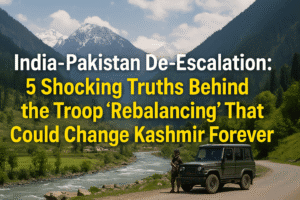India-Pakistan De-Escalation: 5 Shocking Truths Behind the Troop “Rebalancing” That Could Change Kashmir Forever
India and Pakistan cautiously de-escalate military tensions following April’s Pahalgam terror attack, which killed 26 tourists and triggered India’s targeted Operation Sindoor against Pakistan-based terror camps. New Delhi now plans a strategic troop “rebalance,” reverting to pre-conflict positions without compromising readiness, while Islamabad—under global pressure—begins withdrawing its border reinforcements.
Both nations face unspoken pressures: India seeks to revive Kashmir’s tourism-reliant economy, shattered by the attack, while Pakistan grapples with isolation over harboring militant groups. Though mutual pullbacks signal fragile progress, deep-rooted distrust lingers, with India demanding “irreversible action” against terrorism and Pakistan yet to address cross-border militancy. Civilian struggles underscore the human cost—locals in Pahalgam cling to hope for normalcy, even as both armies remain on high alert. The pause offers respite, but lasting peace hinges on Pakistan dismantling terror infrastructure and India addressing regional grievances, a precarious balance in a region where peace remains perpetually tentative.

India-Pakistan De-Escalation: 5 Shocking Truths Behind the Troop “Rebalancing” That Could Change Kashmir Forever
Two weeks after India paused Operation Sindoor—its targeted military response to the devastating April 22 Pahalgam terror attack—both India and Pakistan appear to be cautiously stepping back from heightened border tensions. While New Delhi plans a strategic troop “rebalance,” Islamabad has signaled a return to pre-April military positions, hinting at fragile progress toward de-escalation. Here’s what this shift means for regional stability.
The Trigger: Pahalgam and the Path to Operation Sindoor
The April 22 attack in Pahalgam, a scenic Kashmir town popular with tourists, marked a grim turning point. Militants linked to Pakistan-based groups killed 26 people, including families vacationing in the region. India’s swift intelligence assessments pointed to cross-border involvement, prompting Operation Sindoor on May 7. Precision strikes targeted terror infrastructure in Pakistan-occupied Kashmir and key Jaish-e-Mohammed (JeM) and Lashkar-e-Taiba (LeT) hubs, deploying advanced assets like Rafale jets with SCALP missiles and BrahMos cruise missiles.
Pakistan’s retaliatory strikes on civilian areas and attempted drone incursions were largely thwarted, but the exchanges underscored the risk of uncontrolled escalation between the nuclear-armed neighbors.
The “Rebalance”: What’s Changing?
India’s Strategy:
- Contrary to Pakistan’s large-scale troop mobilization, India avoided mass deployments, opting instead for targeted movements. Restrictions on troop leave and training programs have now eased, signaling a return to routine operations.
- Military sources emphasize this is a strategic recalibration, not a withdrawal. Assets moved to forward positions will revert to bases, maintaining readiness without overt provocation.
Pakistan’s Rollback:
- Pakistan’s aggressive posturing—massing troops and artillery near the international border—is being dialed back. Pre-April positions suggest a tactical retreat, possibly under international pressure or economic strain.
Confidence-Building Measures:
Behind-the-scenes diplomatic channels (likely third-party mediated) may have facilitated this mutual pullback. Both sides recognize the economic and humanitarian costs of prolonged mobilization, especially after Pahalgam’s blow to Kashmir’s tourism-dependent economy.
Why Now? The Unspoken Pressures
- Global Scrutiny: Pakistan’s role in harboring terror groups faced renewed condemnation post-Pahalgam. India’s calibrated response earned tacit support from Western nations, leaving Islamabad isolated.
- Economic Fatigue: Pakistan’s crippling debt crisis and India’s focus on economic growth make sustained conflict untenable.
- Local Sentiment: In Kashmir, residents and businesses voiced desperation over the tourism collapse. Restoring normalcy is critical to rebuilding trust and livelihoods.
The Delicate Road Ahead
While de-escalation offers hope, underlying tensions persist:
- Trust Deficit: India remains skeptical of Pakistan’s commitment to curbing terrorism. The Hurriyat’s recent protests in Muzaffarabad (PoK) highlight unresolved grievances.
- Military Readiness: Both armies retain high alert levels. As Colonel Sofiya Qureshi (Indian Army) stated, “Any provocation will meet a proportionate response.”
- Diplomatic Tightrope: India’s Foreign Secretary reiterated demands for “irreversible action” against terror groups, a sticking point in past dialogues.
Human Cost: Beyond the Headlines
The Pahalgam attack’s aftermath reveals deeper scars:
- Survivors and victims’ families await justice, with many questioning the efficacy of border policies.
- Local vendors and hoteliers, already battered by years of instability, now face an uncertain summer tourist season. “We’re not giving up,” says hotel owner Arif Malik, “but how long can we wait?”
Conclusion: A Fragile Peace
The troop rebalance is a pragmatic pause, not a resolution. For lasting peace, Pakistan must address its terror infrastructure, while India faces pressure to address Kashmiri aspirations. As global powers watch, both nations walk a knife’s edge—aware that miscalculation could ignite a crisis neither can afford.
You must be logged in to post a comment.